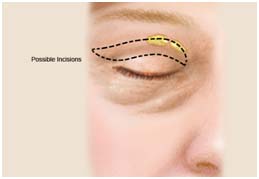Overview
Blepharoplasty removes excess skin and/or fat in the upper or lower eyelid. Prior to surgery, an eye examination may be performed by an eye specialist. Visual field testing may be recommended to determine whether blepharoplasty would be cosmetic (to improve appearance) or functional (to improve vision). If a person's vision is limited due to excess upper eyelid skin, insurance may provide coverage.

Blepharoplasty may be done alone or in combination with other facial cosmetic procedures.
Why Eyelid Surgery?
As we age, excess skin forms in the eye area, and the skin loses elasticity. Fatty tissue can accumulate under the skin. Your eyes will "look older" because these aging processes leave the eyes appearing tired, wrinkled or puffy. Even with good skincare and eyecare, wrinkles, puffiness and drooping eyelids will catch up to you. Genetic factors and body chemistry can cause these aging effects in younger people. Plastic surgery may restore a youthful and refreshed appearance to your eyes.
Before The Surgery
The initial consultation with your surgeon is very important. The surgeon will need your complete medical history, so check your own records ahead of time and be ready to provide this information. Be sure to inform your surgeon if you have any allergies; if you're taking any vitamins, medications (prescription or over-the-counter), or other drugs; and if you smoke.In this consultation, your surgeon or a nurse will test your vision and assess your tear production. You should also provide any relevant information from your ophthalmologist or the record of your most recent eye exam. If you wear glasses or contact lenses, be sure to bring them along.
You and your surgeon should carefully discuss your goals and expectations for this surgery. You'll need to discuss whether to do all four eyelids or just the upper or lower ones, whether skin as well as fat will be removed, and whether any additional procedures are appropriate.
Your surgeon will explain the techniques and anesthesia he or she will use, the type of facility where the surgery will be performed, and the risks and costs involved. (Note: Most insurance policies don't cover eyelid surgery, unless you can prove that drooping upper lids interfere with your vision. Check with your insurer.)
Don't hesitate to ask your doctor any questions you may have, especially those regarding your expectations and concerns about the results.
The Blepharoplasty Procedure
Your surgeon will make incisions along the line creases of the upper eyelid and possibly along the outer lower rim of the eye's skin. When removing fatty tissue, but not skin, the surgeon may perform a transconjunctival blepharoplasty with an incision inside the lower rim of the eye's skin. These incisions often reach the outer corners of the eyes. The surgeon then divides the fatty tissue and muscle from the skin so that excess skin, fat or muscle can be removed.Eyelid surgery is often performed under local anesthesia — while you are sedated, numbed and awake — in an outpatient surgery center, surgeon's office or hospital. General anesthesia (meaning, while you are asleep) may be used. Be sure to discuss the appropriate type of anesthesia with your doctor and the anesthesia provider.
Depending on the extent of the procedure, time in surgery may be up to three hours. Patients return home typically within hours of the surgery.
What Does Blepharoplasty Do?
It refreshes and rejuvenates the look by eliminating certain features that contribute to make one look older and tired, such as the 'bags' beneath the eyes and the excess skin in the 'drooping' upper eyelids.
It eliminates lumps generated by the accumulation of fat inside the eyelids. It improves the sight by reducing the upper eyelids when they droop too much and interfere with the vision. It brightens the look and is often performed together with a temporal face lift.
What Does Blepharoplasty NOT Do?
It does not eliminate crow's feet. It does not eliminate dark circles under the eyes. It does not lift the eyebrows nor does it change their shape. If you think your eyebrows are too low or too straight, please read the information on brow lift surgery that we provide.
After Your Surgery
After surgery, the surgeon will probably lubricate your eyes with ointment and may apply a bandage. Your eyelids may feel tight and sore as the anesthesia wears off, but you can control any discomfort with the pain medication prescribed by your surgeon. If you feel any severe pain, call your surgeon immediately.You will receive a list of instructions to follow for several days, including:
- the proper way to clean your eyes
- use of cold compresses
- use of lubricating eye drops
- head elevation
- no makeup
- no alcohol
- no television
- no contact lenses
Stitches are removed about a week after surgery. Bruising and swelling will continue to decrease after stitches are removed. Sunglasses and protective sun block are required for several weeks.
Normal activities can resume after about 10 days, though strenuous activities such as lifting, bending and exercise can resume after about three weeks.
Complications And Risks Of Blepharoplasty
Following surgery, you may experience tearing, itchy, burning eyes, dry eyes, light sensitivity and blurred or double vision, which can persist for several days. Lubricating eye drops. can relieve these complications. There will also be some swelling around the eyes. Scarring is another possible complication.Sometimes patients have difficulty closing their eyes when asleep; though rare, this complication can be permanent. The lower lids may appear to be pulled down; this rare condition, called ectropion, may require additional surgery. The eyes may also look somewhat asymmetrical.
For more information, medical assessment and medical quote
as email attachment to
Email : - info@wecareindia.com
Contact Center Tel. (+91) 9029304141 (10 am. To 8 pm. IST)
(Only for international patients seeking treatment in India)










